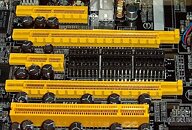- Joined
- Oct 9, 2007
- Messages
- 47,895 (7.38/day)
- Location
- Dublin, Ireland
| System Name | RBMK-1000 |
|---|---|
| Processor | AMD Ryzen 7 5700G |
| Motherboard | Gigabyte B550 AORUS Elite V2 |
| Cooling | DeepCool Gammax L240 V2 |
| Memory | 2x 16GB DDR4-3200 |
| Video Card(s) | Galax RTX 4070 Ti EX |
| Storage | Samsung 990 1TB |
| Display(s) | BenQ 1440p 60 Hz 27-inch |
| Case | Corsair Carbide 100R |
| Audio Device(s) | ASUS SupremeFX S1220A |
| Power Supply | Cooler Master MWE Gold 650W |
| Mouse | ASUS ROG Strix Impact |
| Keyboard | Gamdias Hermes E2 |
| Software | Windows 11 Pro |
PCI-SIG, the consortium that governs the PCI Express I/O interconnect, released draft specification version 0.7 for the upcoming PCI-Express 7.0 standard (or PCIe Gen 7). An early-2025 release of this draft could indicate that PCIe Gen 7 gets finalized into specification version 1.0 by the end of 2025, from where implementers can pick it up to design their devices around. We are now at 32 Gbps per lane per direction with PCIe Gen 5, and PCIe Gen 6 doubles it to 64 Gbps, which would mean PCIe Gen 7 will double that further to 128 Gbps per lane per direction. PCI-Express 7.0 x1 would offer the same bandwidth as PCI-Express 3.0 x16. We could realistically expect the first computing platforms implementing PCIe Gen 7 to come out around 2027 or even 2028. PCIe forms the physical layer for a number of derivative standards, such as CXL, Thunderbolt, USB (USB 3.0 onwards), NVMe, SDexpress, CFexpress, and DMI.

Many Thanks to Tumble George for the tip
View at TechPowerUp Main Site | Source

Many Thanks to Tumble George for the tip
View at TechPowerUp Main Site | Source










